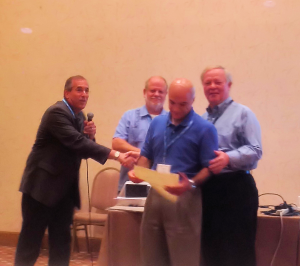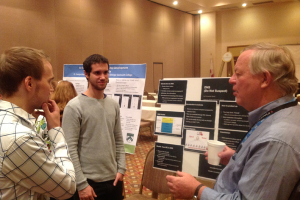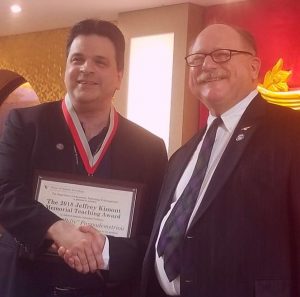
Dr. Carlson and Dr. Hasso receiving the Best Paper award
Dr. C. Robert Carlson, Dean of the School of Applied Technology, earned the best paper award at the 2nd Annual Conference on Research in Information Technology (RIIT) held in conjunction with the ACM 14th Annual Conference in Information Technology Education (SIGITE), October 10-12. Dr. Carlson, along with Dr. Sargon Hasso, a former PhD student of Dr. Carlson’s, presented the paper “Design Patterns as First-Class Connectors” in the Software Development track. Their approach is a compositional model based on design patterns by abstracting their behavioral model using role modeling constructs. They demonstrated their technique by presenting a simple case study complete with design and implementation code. Dr. Hasso is currently employed at Wolters Kluwer.
Dr. Carlson was accompanied to the conference by Industry Professor Ray Trygstad, Associate Chair of IIT’s Department of Information Technology and Management. Professor Trygstad also serves as the Chair of the National Board of Directors for Gamma Nu Eta, the National Information Technology Honor Society. He represented Gamma Nu Eta, who was a Silver Sponsor for the conference.
Dr. Carlson also served as Session Chair for the presentations of “Leveraging HCI in Teaching Mobile, ‘Anywhere and Everywhere’ IT” and “Flipping the Classroom – Is it for you?” as part of the Mobile IT Technology track of the conference.

IIT alumnus Fernando Seror Garcia at the Poster Session
As part of the Security 1 track, IIT alumnus Mikhail Zaturenskiy, who worked with Professor Bill Lidinsky, presented his paper “MP3 Files as a Steganography Medium.” This paper looks at ways to hide information inside MP3 files and proposes four largely unexplored techniques: unused header bit stuffing, unused side information bit stuffing, empty frame stuffing, and ancillary bit stuffing.
As part of the RIIT Poster Session, IIT 2013 ITM alumnus Fernando Seror Garcia, presented his project, “DNS (Do Not Suspect).” The purpose of this project is to see if it would be possible for an attacker to use the DNS protocol to communicate with a bot of his own in an infected host in order to avoid being detected.






 School of Applied Technology Dean Dr. C. Robert “Bob” Carlson will chair Paper Session A2: Mobile and will present a paper, “
School of Applied Technology Dean Dr. C. Robert “Bob” Carlson will chair Paper Session A2: Mobile and will present a paper, “